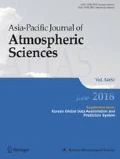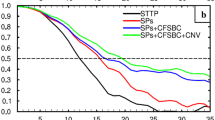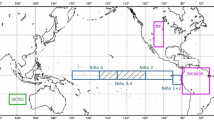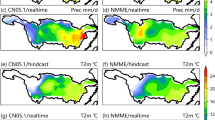Abstract
This article describes a three way inter-comparison of forecast skill on an extended medium-range time scale using the Korea Meteorological Administration (KMA) operational ensemble numerical weather prediction (NWP) systems (i.e., atmosphere-only global ensemble prediction system (EPSG) and ocean-atmosphere coupledEPSG) and KMA operational seasonal prediction system, the Global Seasonal forecast system version 5 (GloSea5). The main motivation is to investigate whether the ensemble NWP system can provide advantage over the existing seasonal prediction system for the extended medium-range forecast (30 days) even with putting extra resources in extended integration or coupling with ocean with NWP system. Two types of evaluation statistics are examined: the basic verification statistics - the anomaly correlation and RMSE of 500-hPa geopotential height and 1.5-meter surface temperature for the global and East Asia area, and the other is the Real-time Multivariate Madden and Julian Oscillation (MJO) indices (RMM1 and RMM2) - which is used to examine the MJO prediction skill. The MJO is regarded as a main source of forecast skill in the tropics linked to the mid-latitude weather on monthly time scale. Under limited number of experiment cases, the coupled NWP extends the forecast skill of the NWP by a few more days, and thereafter such forecast skill is overtaken by that of the seasonal prediction system. At present stage, it seems there is little gain from the coupled NWP even though more resources are put into it. Considering this, the best combination of numerical product guidance for operational forecasters for an extended medium-range is extension of the forecast lead time of the current ensemble NWP (EPSG) up to 20 days and use of the seasonal prediction system (GloSea5) forecast thereafter, though there exists a matter of consistency between the two systems.
Similar content being viewed by others
References
Arribas, A., 2004: Results of an initial stochastic physics scheme for the Met Office Unified Model. Forecasting Research Technical Report No. 452, 26 pp.
Brunet, G., and Coauthors, 2010: Collaboration of the weather and climate communities to advance subseasonal to seasonal prediction. Bull. Amer. Meteor. Soc., 91, 1397–1406, doi:10.1175/2010BAMS3013.1.
Ferranti, L., T. N. Palmer, F. Molteni, and E. Klinker, 1990: Tropicalextratropical interaction associated with the 30-60 day oscillation and its impact on medium and extended range prediction. J. Atmos. Sci., 47, 2177–2199.
Ferranti, L., and S. Corti, 2011: New clustering products. ECMW. Newsletter, 127, 6–11.
Hewitt, H. T., D. Copsey, I. D. Culverwell, C. M. Harris, R. S. R. Hill, A. B. Keen, A. J. McLaren, and E. C. Hunke, 2011: Design and implementation of the infrastructure of HadGEM3: The next-generation Met Office climate modelling system. Geosci. Mode. Dev., 4, 223–253, doi:10.5194/gmd-4-223-2011.
Hunke, E. C., and W. H. Lipscomb, 2010: CICE: the Los Alamos sea ice model, documentation and software user’s manual, Version 4.1. Tech. Rep. LA-CC-06-012, 76 pp.
Kistler, R., and Coauthors, 2001: The NCEP-NCAR 50-year reanalysis: Monthly means CD-ROM and documentation. Bull. Amer. Meteor. Soc., 82, 247–267.
Kalnay, E., and Coauthors, 1996: The NCEP/NCAR 40-year reanalysis project. Bull. Amer. Meteor. Soc., 77, 437–471.
Kang, I.-S., and H. M. Kim, 2010: Assessment of MJO predictability for boreal winter with various statistical and dynamical models. J. Climate, 23, 2368–2378, doi:10.1175/2010JCLI3288.1.
MacLachlan, C., and Coauthors, 2015: Global Seasonal forecast system version 5 (GloSea5): A high-resolution seasonal forecast system. Quart. J. Roy. Meteor. Soc., 141, 1072–1084, doi:10.1002/qj.2396.
Madden, R. A., and P. R. Julian, 1971: Detection of a 40-50 day oscillation in the zonal wind in the tropical Pacific. J. Atmos. Sci., 5, 702–708.
Madec, G., 2008: NEMO reference manual, ocean dynamics components. note du Pole 1619, 217 pp.
Seo, K.-H., and S.-W. Son, 2012: The global atmospheric circulation response to tropical diabatic heating associated with the Madden-Julian oscillation during northern winter. J. Atmos. Sci., 69, 79–96, doi: 10.1175/2011JAS3686.1.
Seo, K.-H., W. Wang, J. Gottschalck, Q. Zhang, J.-K. E. Schemm, W. R. Higgins, and A. Kumar, 2009: Evaluation of MJO forecast skill from several statistical and dynamical forecast models. J. Climate, 22, 2372–2388.
Shelly, A., P. Xavier, D. Copsey, T. Johns, J. M. Rodríguez, S. Milton, and N. Klingaman, 2014: Coupled versus uncoupled hindcast simulations of the Madden-Julian Oscillation in the Year of Tropical Convection. Geophys. Res. Lett., 41, 5670–5677, doi:10.1002/2013GL059062.
Shutts, G., 2005: A kinetic energy backscatter algorithm for use in ensemble prediction systems. Quart. J. Roy. Meteor. Soc., 612, 3079–3102.
Valcke, S., 2006: OASIS3 User Guide. PRISM-Support Initiative Report No. 3, 68 pp.
Vitart, F., 2013: Evolution of ECMWF sub-seasonal forecast skill scores over the past 10 years. ECMWF Technical Memorandum, No. 694, 28 pp.
Vitart, F., G. Balsamo, R. Buizza, L. Ferranti, S. Keeley, L. Magnusson, F. Molteni, and A. Weisheimer, 2014: Sub-seasonal predictions. ECMWF Technical Memorandum, No. 738, 45 pp.
Wheeler, M. C., and H. H. Hendon, 2004: An all-season real-time multivariate MJO index: Development of an index for monitoring and prediction. Mon. Wea. Rev., 132, 1917–1932.
Won, D., Y. S. Lee, Y. H. Kang, and H. J. Ham, 2015: Operational system description of GloSea5 in KMA and verification result of 2014. KMA Technical Report, 2015-04, 142 pp.
Author information
Authors and Affiliations
Corresponding author
Rights and permissions
About this article
Cite this article
Park, S., Kim, DJ., Lee, SW. et al. Comparison of extended medium-range forecast skill between KMA ensemble, ocean coupled ensemble, and GloSea5. Asia-Pacific J Atmos Sci 53, 393–401 (2017). https://doi.org/10.1007/s13143-017-0035-2
Received:
Accepted:
Published:
Issue Date:
DOI: https://doi.org/10.1007/s13143-017-0035-2




